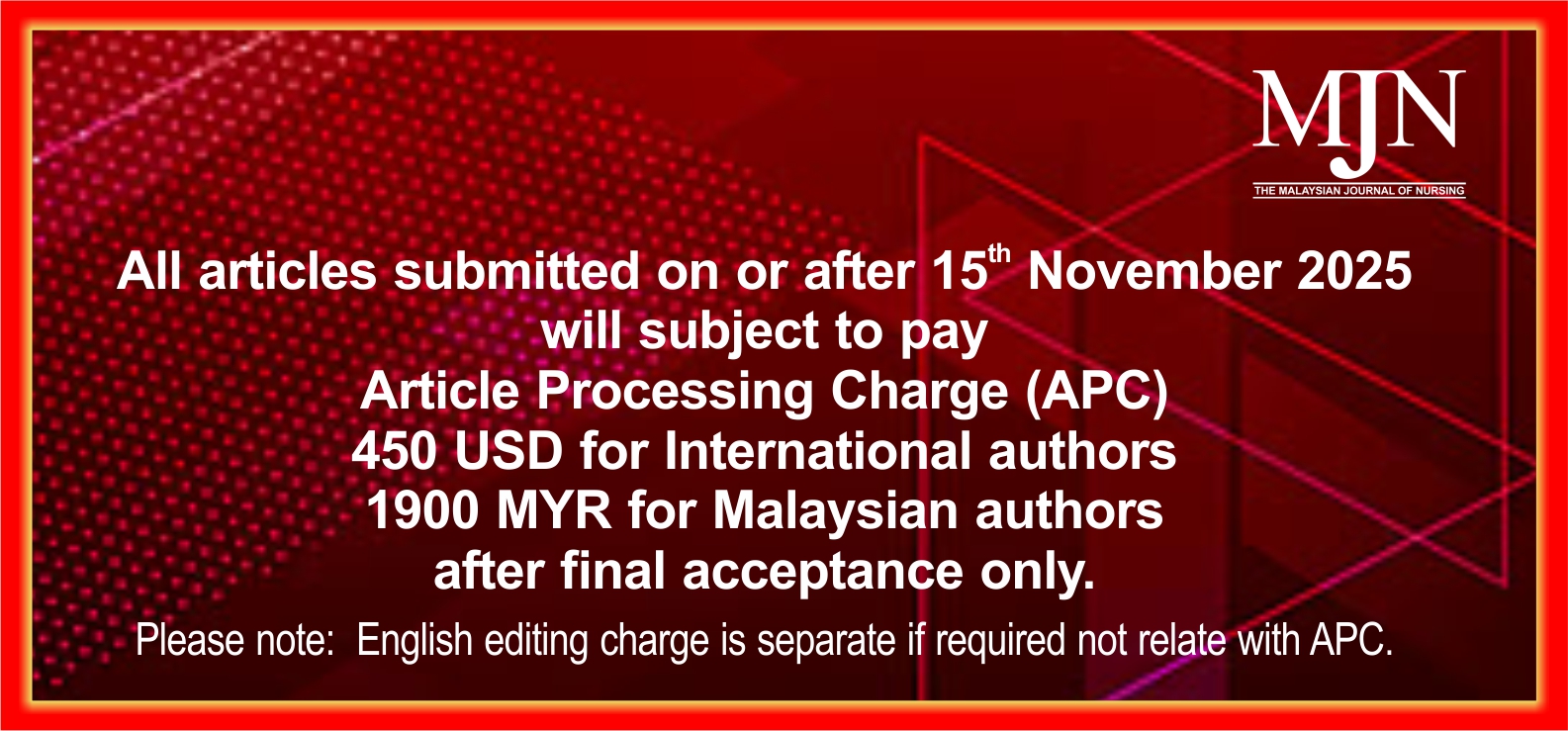Relationship Between Heat Stress and Job Fatigue with Stress Levels in Employess at CV. Fatra Karya Logam
DOI:
https://doi.org/10.31674/mjn.2023.v14i04.002Abstract
Background: According to the Institution of Social Security Employment, based on data for 2020, there was an increase in cases of work accidents, with 177,000 cases recorded. One of the common problems for employees in the industrial environment is heat exposure. Heat stress is one of the working conditions of physical factors in the work environment, which is an additional burden for employees. Objective: To determine the relationship between heat stress, job fatigue, and stress levels in employees at CV. Fatra Karya Logam. Methods: This is a quantitative research method with a cross-sectional design. The population and sample in this study were employees in the production section of CV. Fatra Karya Logam, as many as 30 people. Results: The results of measuring heat stress with medium workloads in the production section of CV. Fatra Karya Logam exceed NAV (> 28.0ºC), it is known that the average Wet Bulb Globe Temperature (WBGT) in CV. Fatra Karya Logam is 31.4°C, and statistical tests show that there is a relationship between heat stress and stress levels for employees at CV. Fatra Karya Logam with a value of p = 0.000, and there is a significant relationship between job fatigue and stress levels for employees at CV. Fatra Karya Logam with p value = 0.006. Conclusion: Therefore, to manage the impacts properly and avoid health issues or worse outcomes while working, we must understand what triggers job tiredness and work stress. Recommendation: by identifying causes of fatigue and work stress, employees can handle the effects properly to prevent health problems and worse consequences during work.
Keywords:
Heat Stress, Job Fatigue, Stress LevelDownloads
References
Arnani, H. C. (2019). Perbedaan Kelelahan Kerja Pada Shift Pagi Dan Shift Malam Karyawan Bagian Produksi Di Pabrik Teh Ptpn IV Bah Butong (Doctoral dissertation, Universitas Islam Negeri Sumatera Utara). http://repository.uinsu.ac.id/id/eprint/8005
Djafri, D., Chongsuvivatwong, V., & Geater, A. (2015). Effect of the September 2009 Sumatra earthquake on reproductive health services and MDG 5 in the city of Padang, Indonesia. Asia Pacific Journal of Public Health, 27(2), NP1444-NP1456. https://doi.org/10.1177/1010539513496
Dotulong, D. P. A., Kasumawati, F., & Listiana, I. (2022). Hubungan Antara Usia, Kelelahan Kerja Dan Tingkat Stress Kerja Dengan Siklus Menstruasi Pada Pekerja Back Office Di Pt. Sun Star Prima Motor Kota Bogor. Frame of Health Journal, 1(2), 87-95.
Fajriah, N. (2018). Hubungan Tekanan Panas dan Beban Kerja Fisik dengan Perubahan Tekanan Darah pada Pekerja Bagian Giling Simplisia PT. Jamu Air Mancur Surakarta.
Juliana, M., Camelia, A., & Rahmiwati, A. (2018). Analisis faktor risiko kelelahan kerja pada karyawan bagian produksi PT. Arwana anugrah keramik, tbk. Jurnal Ilmu Kesehatan Masyarakat, 9(1), 53-63. https://doi.org/10.26553/jikm.2018.9.1.53-63
Marif, A. (2013). Faktor-faktor yang Berhubungan dengan Kelelahan pada Pekerja Pembuatan Pipa dan Menara Tambat Lepas Pantai (EPC3) di Proyek Banyu Urip PT Rekayasa Industri, Serang-Banten Tahun 2013. http://repository.uinjkt.ac.id/dspace/handle/123456789/26493
Maulana, L. (2018). Hubungan Tekanan Panas dengan Kelelelahan Kerja di bagian Produksi Pada Pekerja PT. Perkebunan Nusantara II Pabrik Gula Kwala Madu Tahun 2017 (Doctoral dissertation). http://repositori.usu.ac.id/handle/123456789/3595
Mohammad, K. S., Shafik, S. A., & Mahmoud, M. T. (2023). Assessment of Heat Stress Exposure among Outdoor Cleansing Workers in Helwan University. The Egyptian Journal of Hospital Medicine, 90(1), 869-874. https://doi.org/10.21608/ejhm.2023.279953
Nada, K. F., Kasumawati, F., & Fadhilah, H. (2022). Hubungan Antara Faktor Individu Dan Faktor Langsung Keluhan Dermatitis Kontak Iritan Pada Pekerja Di Cv. Fatra Karya Logam Kabupaten Tangerang. Frame of Health Journal, 1(2), 54-63.
Notoatmodjo, S. (2010). Metodologi Penelitian Kesehatan, Rineka Cipta. Jakarta. Indonesia.
Notoatmodjo, S. (2012). Metodologi Penelitian Kesehatan, Jakarta, PT Rineka Cipta. Profil SMA, 2.
Nurmianto, E. (2004). Ergonomi konsep dasar dan aplikasinya edisi kedua. Surabaya: Guna Widya.
Ramadhani, F. (2016). Hubungan Kelelahan Kerja dengan Stres Kerja pada Perawat di Ruang Rawat Inap RSUD Dr. Pirngadi Medan Tahun 2016 (Doctoral dissertation, Universitas Sumatera Utara).
Ratih, A. D. (2012). Hubungan Antara Kelelahan Kerja dengan Stress Kerja pada Tenaga Kerja Bagian Weaving PT. Iskandar Indah Printing Textile Surakarta.
Rinawati, S., & Astuti, W. (2017). Hubungan Tekanan Panas Dengan Kelelahan Dan Tekanan Darah Pada Pekerja Kerajinan Tembaga Wirun. http://hdl.handle.net/11617/8972
Sholihah, Q., Kuncoro, W., Sari, R. A., Lukodono, R. P., & Swara, S. E. (2019). Risk management of the implementation of work health safety in radiology. Utopía y praxis latinoamericana: revista internacional de filosofía iberoamericana y teoría social, (6), 142-152.
Sugiyono, P. D. (2019). Metode Penelitian Kuantitatif, Kualitatif, dan R&D (Sutopo). Bandung: CV. Alfabeta.
Sunyoto, D. (2012). Manajemen Sumber Daya Manusia. yogyakarta: CAPS (center for academic publishing service).
Windyananti, A. (2010). Hubungan antara kelelahan kerja dengan stress kerja pada tenaga kerja di pengolahan kayu lapis Wreksa Rahayu, Boyolali.
Published
How to Cite
Issue
Section
License
Copyright (c) 2023 The Malaysian Journal of Nursing (MJN)

This work is licensed under a Creative Commons Attribution-NonCommercial-NoDerivatives 4.0 International License.



































